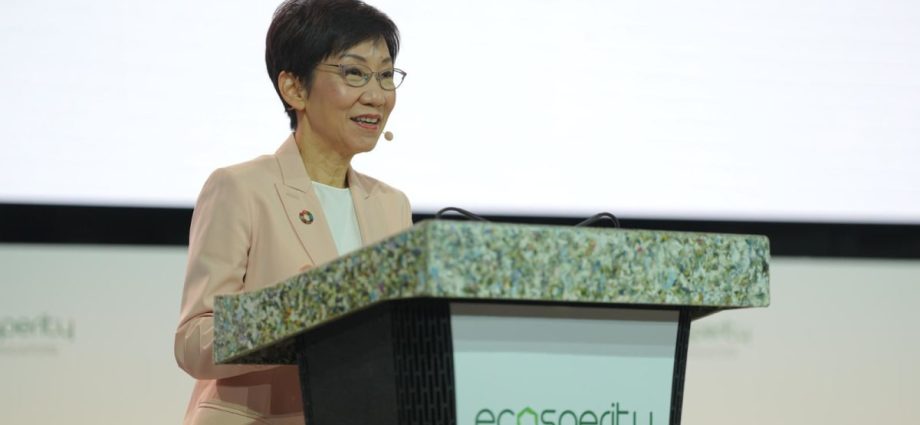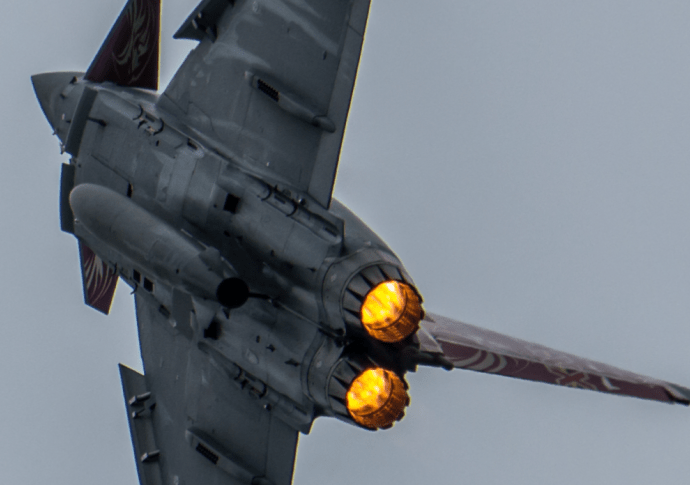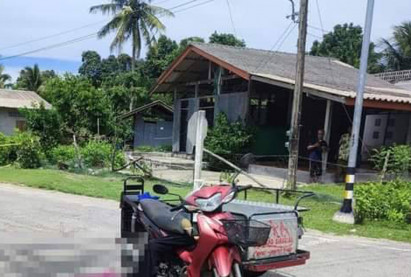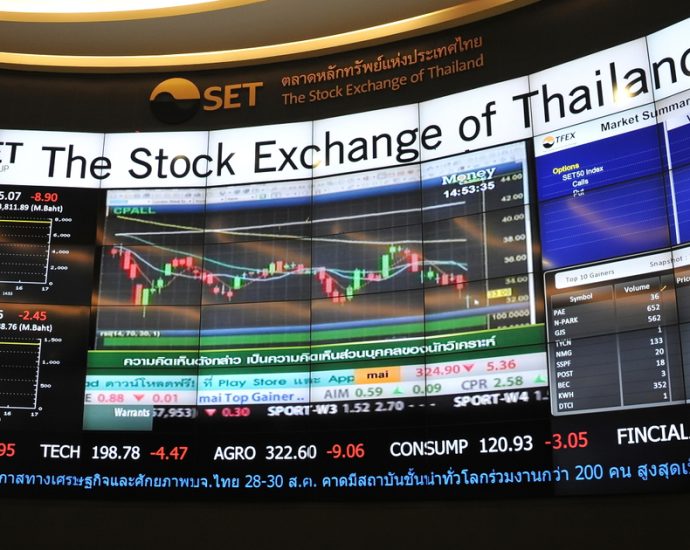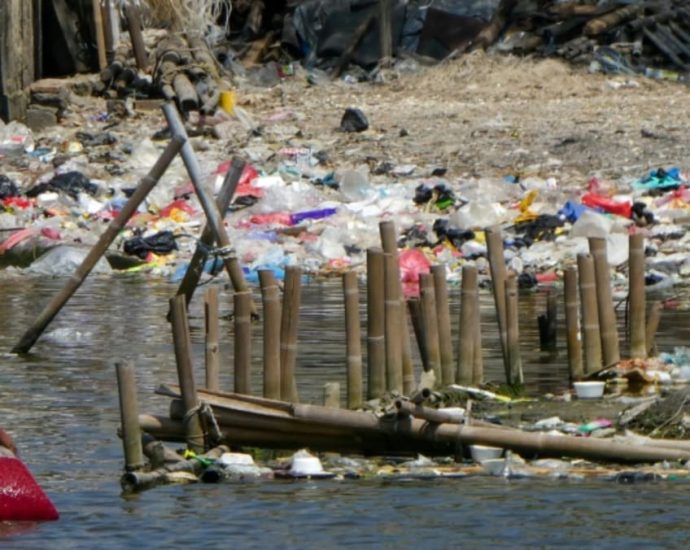Singapore committed to decarbonisation goals while uplifting workers in the transformation: Grace Fu
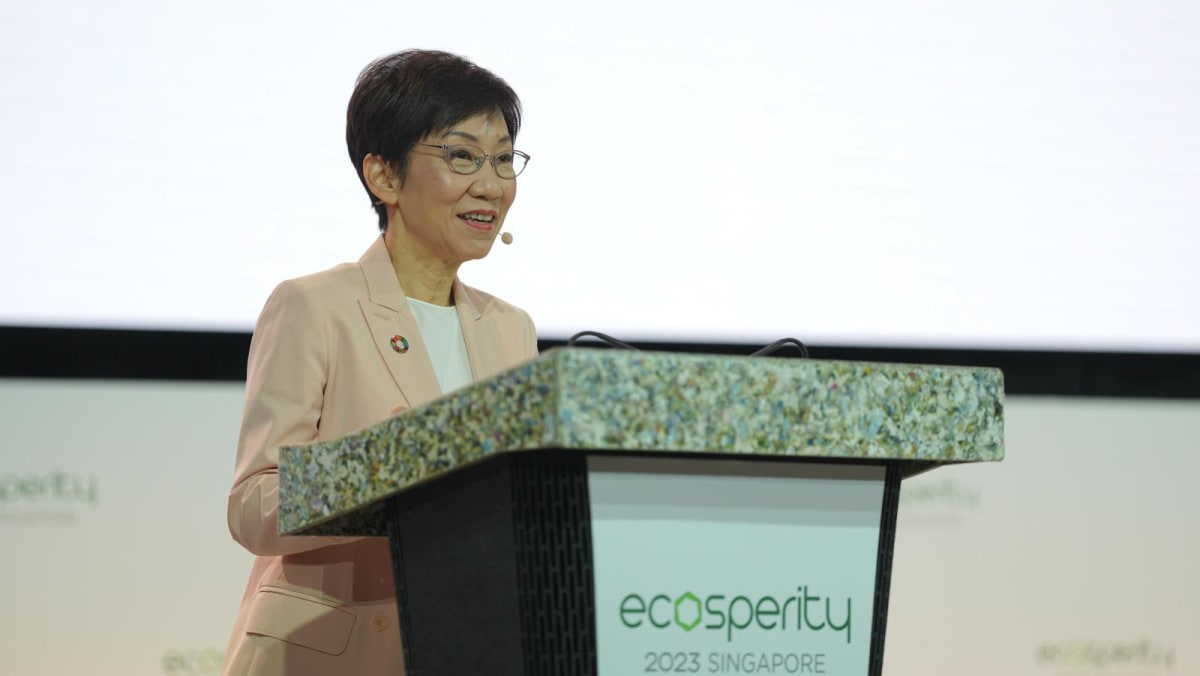
During her keynote address, Ms Fu said that Singapore is committed to meeting its national climate target to achieve net zero emissions by 2050.
Citing a report that mentioned finance, technology and international cooperation as three critical enablers for accelerated climate action, Ms Fu elaborated on how Singapore could contribute in these aspects.
Singapore must accelerate the development of decarbonisation technologies to make them commercially viable in order to harness their potential for decarbonisation at scale, Ms Fu said.
She raised the example of low-carbon hydrogen as a potential alternative to fossil fuels in the maritime and aviation sectors. Hydrogen can potentially supply up to half of Singapore’s power needs by 2050, she said.
“More importantly, it has the potential to unlock global energy trade, through its carrier forms that can be stored and transported over long distances. This will connect regions with abundant low-cost renewable energy with those that have limited renewable energy potential.
“However, the technology and supply chains are still nascent, and large-scale deployment has not yet been demonstrated.”
Another problem was the shortfall in funds to finance net zero goals. The solution to address this, Ms Fu said, is the scaling of blended finance, which is public, multilateral, or philanthropic funding “coming in as catalytic capital, to improve the bankability of green projects and encourage private investments”.
The development of credible carbon markets is another breakthrough in finance, as carbon credits are key instruments that “channel financing to mitigation projects which would otherwise not be bankable nor implementable”, said Ms Fu.
“(Singapore) will allow companies to use high-quality international carbon credits to offset up to five per cent of their taxable emissions from next year onwards. This could spur local demand in carbon markets, hence supporting the growth of a vibrant international carbon market and channel financing to mitigation projects internationally,” she added.
Pita: Allies already working on issues facing government

The eight parties that hope to form the next government have set up more working groups as they consider themselves as already beginning work, according to the leader of the election-winning Move Forward Party.
Representatives of the eight parties met at Pheu Thai headquarters on Tuesday and formed five more working groups. These would handle issues that interest the general public, had an impact and had not been addressed by the present, outgoing government, MFP leader Pita Limjaroenrat told reporters afterwards.
The new working groups would look into issues relating to the digital economy, corruption, the shortage of medical personnel, economic and social equality, and land reform, he said.
“I hope they will find answers for society pending the formation of the (new) government. There are four or five issues that have not been addressed by the (present) government and await solutions from the new government. This is an early start (to work),” Mr Pita said.
Last week the eight allied parties set up seven working groups – on energy prices, drought, deep South problems, constitutional amendment, environmental problems, economic issues and narcotics.
The parties had a single representative in each working group, Mr Pita said.
On Tuesday, the eight allies followed up wih five more working groups. Issues they would look into included the impact of the expiry late next month of the waiver of excise tax on the price of diesel, he said.
In a few weeks representatives of the working groups would have meetings in provinces, when they would gather facts on matters at issue, he said.
The eight former opposition parties unofficially won 313 House seats at the May 14 general election. However, Mr Pita, who hopes to be the next prime minister, is facing complaints about his qualifications linked to his 42,000 shares in iTV Plc.
The constitution prohibits a shareholder of a media organisation from running in a general election.
Mr Pita said on Tuesday he had transferred the shares to relatives late last month and he had previously held them only because he was the manager of his late father’s estate.
Germans the latest to help train Chinaâs fighter pilots
China continues to recruit former NATO fighter pilots to sharpen and advance its air force’s fighting skills, striking deals that have raised security concerns in several Western countries.
This month, Der Spiegel reported that three former German fighter pilots who flew Tornado and Eurofighter Typhoon jets had trained People’s Liberation Army-Air Force (PLA-AF) fighter pilots.
The report said the German ex-pilots earned princely sums for training the PLA fliers in military expertise, reputedly confidential operational tactics and even attack scenarios such as an air offensive against Taiwan.
Der Spiegel reports that in response the Bundestag’s Parliamentary Oversight Panel has addressed the “professional activity of public servants following the end of their employment.”
The report also said that the German Defense Ministry has confirmed that China is using external agencies to recruit former NATO pilots as trainers, posing a significant danger that not only basic flight skills would be imparted but also sensitive tactics, techniques and procedures.
In a similar case, news.com.au reported on October 2022 that China is recruiting former Royal Australian Air Force (RAAF) fighter pilots for the same purpose, with an anonymous former RAAF pilot saying that he has been offered nearly US$1 million a year to train PLA-AF fighter pilots. The report said that such incidents warranted an investigation by the Australian government to develop recommendations to deal with the problem.
That same month, Asia Times reported on China’s efforts to lure former British fighter pilots to work as trainers for its air force, with 30 British pilots being offered US$270,000 a year. While none of the former pilots have flown the F-35, currently the most advanced fighter in the Royal Air Force (RAF), the pilots have flown older sophisticated aircraft such as the Eurofighter Typhoon, Jaguar, and Tornado.

China has also dangled cash to recruit former US military pilots. In the same month, Forbes reported that a former US Marine Corps (USMC) AV-8B Harrier pilot was arrested in Australia following reports that China has recruited ex-RAF pilots to provide adversary training to Chinese fighter pilots.
The source notes that a former USMC AV-8B Harrier pilot would be an invaluable resource to China as it is developing its J-18 Red Eagle vertical takeoff and landing (VTOL) fighter jet and seeks to better understand US and NATO’s VTOL operations.
Although the recruited former NATO pilots are unfamiliar with the latest fighter jets, they will still approach mission planning and operations the same way as their active-duty counterparts, helping modernize the PLA-AF’s institutional mentality.
The Ukraine war has exposed the flaws of Russia and China’s “command control” top-down, centralized leadership structure, contrasting with NATO’s preference for “mission command” lower-level leadership to take the initiative in operations.
Russia and China’s command control may be suited for large-scale operations due to a perceived necessity to maintain tight political control over their militaries.
However, it may also be due to their reliance on hastily-trained and rapidly-mobilized mass forces, which may not have the operational and tactical skill and initiative to execute sophisticated plans.
Such weakness may be reflected in China’s fighter pilot training, which it now seeks to address with the help of former NATO pilots.
In January 2023, Asia Times reported that PLA-AF fighter pilots fresh out of training are sometimes rushed into action over the South China Sea, in some cases just a month after completing their training program.
Although the PLA-AF has made significant progress in fielding increasingly advanced aircraft, it’s not clear whether its pilots have been able to keep pace with the advances.
The PLA-AF’s pilot training program is known to have several shortfalls, which may be connected to China’s command control culture.
These are believed to include poor lead-in flight skills, complacency in conducting flight exercises, insufficient coordination between PLA-AF sub-branches, lack of experienced flight instructors, a “nanny approach” to training, and assessing pilots on how precise they can perform heavily scripted mission plans instead of flexibly completing objectives.

Der Spiegel notes that one possible objective of the former German pilots working in China may have been to train Chinese pilots to break free of their “command control” mentality, which can eventually translate into more extensive PLA-AF institutional and cultural changes.
Apart from breaking pedantic training practices, former NATO fighter pilots may be instrumental in helping the PLA-AF learn Composite Air Operation (COMAO) mission planning, which entails organizing larger numbers of combat aircraft to multitask over multiple sub-missions and use diversionary tactics.
Former NATO pilots have multiple reasons for taking up China’s offer. Der Spiegel notes that German fighter pilots usually retire at 41 when their reflexes slow and vision deteriorates.
The report also says that German fighter pilots who begin flying at 20 receive half their salary when they turn 41, which is insufficient for most and incentivizes them to look for secondary employment.
China’s efforts to recruit ex-NATO pilots may be part of a “normalize deviance” strategy to gain information on top-tier Western aircraft, such as the F-35. It may also be to convince these former elite military pilots that signing a contract from China is not different from taking one from Saudi Arabia, which unlike China is perceived to be a US ally.
Poor economic and career prospects after retirement may also push former NATO fighter pilots to sign training contracts with China, as older pilots are perceived to be uneconomical to train in newer aircraft, leaving them with bleak career prospects in the commercial aviation industry.
Pattani man shot dead in Narathiwat

NARATHIWAT: A man from neighbouring Pattani was shot dead in broad daylight on a road in Bacho district of this southern province on Tuesday.
The victim was identified by police as Bukholee Toryae, a native of Pattani’s Mai Kaen district.
He was found dead with gunshot wounds, on the ground beside his motorcycle and sidecart, in the middle of a road at Khlorae village Moo 3 in tambon Barae Tai of Bacho district.
The murder was reported to police around 10.45am on Tuesday.
Police were investigating.
Hong Kong seeks court ban on protest anthem
HONG KONG: Hong Kong’s government said on Tuesday (Jun 6) that it had asked the city’s high court to ban the song Glory to Hong Kong, an anthem born out of huge protests in 2019. The government has sought an injunction order, which, if granted, would make Glory to HongContinue Reading
Thai stock exchange completes infrastructure upgrade | stock exchange of thailand, set, nasdaq, technology, upgrade, infrastructure | FinanceAsia

On Wednesday (May 31) Nasdaq and the Stock Exchange of Thailand (SET) announced the launch of a new trading system that is set to provide improved function and efficiency across capital market dealflow and execution.
The upgraded infrastructure is built on Nasdaq-conceived technology that draws on state-of-the-art, in-built market data distribution and surveillance systems which support increasing transaction volumes and product varieties.
“Nasdaq has had a longstanding partnership with SET, having provided technology solutions to the exchange for over a decade. This announcement marks the successful completion of a technology upgrade programme that began in 2019,” Roland Chia, executive vice president and head of Marketplace Technology at Nasdaq, told FinanceAsia.
“It facilitates efficient system integration with widely adopted interfaces based on global standards for order entry and market data, including ITCH and OUCH.”
He shared that following the recent successful launch, SET has plans to integrate additional capabilities into its workflow, including Nasdaq’s Pre-Trade Risk Management, Index calculator, Data platform and other Market Surveillance solutions.
In the announcement, SET president Pakorn Peetathawatchai explained that the new system was inaugurated by the Thailand Futures Exchange last month and achieved a “smooth transition”. He reported particular success in terms of improved efficiency and faster order management.
In a video discussing the infrastructure upgrade, Thirapun Sanpakit, head of SET’s Information Technology division, highlighted the development’s capacity to “boost the competitiveness of the Thai capital market.”
“We believe the solution will enable our customers to achieve the fastest time to market. While also minimising total cost of ownership,” he said.
Sanpakit explained that the upgrade reduces roundtrip order latency to under 40 microseconds and said that it would support the bourse’s pursuit of new product launches. He detailed callable bull-bear contracts (CBBC) in the equity market, and single stock options in the Thailand Future Exchange (TFEX) derivatives market, as likely to go live in the near future.
The Thai bourse boasts the highest liquidity among Asean-based exchanges – a position it has maintained for over a decade. In 2022, capital raised through IPO totalled $3.46 billion, the highest volume among Asean exchanges and fourth largest in Asia after China, South Korea and India. According to Sanpakit, the exchange handles a daily trading volume of $2.5 billion.
SET was not able to comment beyond the press release prior to publication.
¬ Haymarket Media Limited. All rights reserved.
Chase leads to 5 arrests, 8m speed pills seized

Five alleged members of a major drug trafficking network have been arrested and 8 million methamphetamine pills worth about 50 million baht seized in Saraburi province.
The four Thai men and one Lao woman are members of the Jae Cake Sanam Chai drug trafficking network, according to Pol Lt Gen Jiraphat Phumjit, chief of Provincial Police Region 1.
He was briefing news reporters at Kaeng Khoi police station in Saraburi province on Tuesday.
The suspects were identified as Theerahong Phuphiewluang, 32, Phromphong Seelakan, 25, Saran Ketkaew, 23, Thawatchai Intharasongkhor, 66, and Lao national Kesone Misy, 31. They were caught in possession of 8 million meth pills worth about 50 million baht, Pol Lt Gen Jiraphat said.
The arrests were made following an investigation into the activities of a woman named only as Ms Jenjira, known as Cake, the leader of a major drug network, he said.
She had arranged for the transportation of smuggled drugs from a border area in the Northeast to buyers in the Central Plains and the South. (continues below)

Seventeen fertiliser sacks containing 8 million speed pills are found in a Toyota Fortuner on June 2.(Photo: Saraburi public relations office)
On June 2, police began a pursuit of two sport utility vehicles, a Toyota Fortuner and an Isuzu Mu-X, travelling along Chok Chai Road heading towards Lam Phra Phoeng intersection in Pak Thong Chai district of Nakon Ratchasima. The fleeing drivers turned off the highway onto a side road, temporarily evading them. The vehicles were later intercepted and five suspects arrested in Kaeng Khoi district of Saraburi.
The Fortuner was carrying 17 fertiliser sacks containing 4,000 packages with a total of 8 million meth pills. Mr Theerahong was the driver of the Fortuner. The four other suspects were on the Isuzu Mu-X, which travelled ahead as a lookout. Mr Saran drove this vehicle.
During questioning, the suspects allegedly confessed to being paid 40,000 baht each to deliver the drugs. They refused to name the person who hired them.
All were charged with collusion in possession of illicit drugs with intent to sell and handed over to Khaeng Khoi police for legal action, Pol Lt Gen Jiraphat said.
Why Marcos Jr is poking and not appeasing China
Despite careful words from Philippine officials, the latest US-Philippines Balikatan military exercise was a response to China’s increasing assertiveness in the South China Sea.
China’s provocations had become indiscriminate — targeting both uniformed Filipino personnel and small-scale fisherfolk in the Philippines’ exclusive economic zone. China’s aggressive actions had become bolder, making it more difficult to turn a blind eye to the situation.
The 38th Balikatan exercise in April 2023 was the biggest in the three-decade history of their joint combat drills. The exercise did not sit well with Beijing, which immediately released a warning that such activities can aggravate tension in the area.
The Chinese ambassador to the Philippines issued an upfront reproach to the Philippine government about China’s displeasure of such “provocative” activities.
The United States and the Philippines promptly conducted the third 2+2 Ministerial Dialogue on April 11, 2023, in Washington. Top US-Philippines foreign affairs and defense officials issued clear-cut statements about the South China Sea conflict.
The joint statement condemned China’s illegal activities and called for compliance with the 2016 Permanent Court of Arbitration decision, which rejected Beijing’s claims on territory and maritime rights based on its “nine-dash line.” The statement also reiterated the importance of maintaining peace and stability in the Taiwan Strait.
Under President Ferdinand Marcos Jr, the Philippines seems to have turned its back on the China appeasement strategy that characterized the foreign policy of his predecessor.
Former president Rodrigo Duterte moved the Philippines closer to China by downplaying the Arbitral Tribunal award favoring the Philippines. In retrospect, Duterte provided China with ample space to construct a closer and mutually beneficial relationship with the Philippines.

Yet Beijing continued to conduct aggressive actions in the Philippines’ exclusive economic zone targeting the Philippine military and fisherfolk who are more disadvantaged. There was a clear mismatch between Beijing’s words and actions.
It did not help that China reneged on many of its economic commitments to Manila. Beijing failed to fulfill its pledged investment in several big-ticket infrastructure projects.
As a dominant state that wields considerable influence in the economy and security of many countries, China seems to have assumed that vulnerable states, such as the Philippines, would tolerate its belligerent actions.
China had lost sight that the Philippines – like many ASEAN countries – is a post-colonial state, sensitive to the raw ambition of superpowers to dominate and bend them against their will. Beijing overlooked the determination of many domestic actors in these countries to defend their national interest.
The country’s territorial integrity is now under threat from a hegemonic China. Given the Philippine military’s inability to defend the country against a preponderant China, the Philippines moved closer to the United States, which provides the training and capacity to protect its territory.
The Philippines is also vital to US interests because it is a treaty ally that occupies a critical position in the US defense perimeter in Asia — the US alliance architecture which runs from East Asia to the South China Sea and the Western Pacific.
During their meeting on May 1, US President Joe Biden assured Marcos Jr that: “The United States remains ironclad in [its] commitment to the defense of the Philippines, including the South China Sea.”
A stronger Philippines–US alliance has complicated the cost for China to challenge the Philippines over territorial issues. Given the US military’s sophisticated weapons, equipment, and combat training, it is fully capable of deterring China’s advance in the South China Sea.
The enlarged presence of the US military in the northern Philippines can also reinforce more dynamic and collaborative operations in case China attempts to forcefully unify Taiwan with the mainland.
The way China treated the Philippines in the 2010s showed Beijing’s overconfidence as a new global power. During the term of former president Benigno Aquino Jr — when the Philippines filed a case against China in 2013 at the Hague — China refused to participate in the three-year trial.
Instead, Beijing continued to flex through military drills and issuing trade sanctions to the Philippines. Beijing lost a critical opportunity to prove that it respects the rule of law. During Duterte’s presidential term, Beijing wasted the chance to establish that it is a credible and benign great power to its neighbors.

Beijing left Manila with little choice but to take the next best approach, which was to strengthen its alliance with the United States to balance the China threat. This is not to say that the China-Philippines relationship is hopeless.
China can take the time to review its foreign policy and learn from the unexpected consequences of its actions. The strong-arm policy that Beijing used on Manila only aggravates tensions and has proven to be unsustainable in the context of great power competition for influence in Asia.
But Manila can take advantage of warmer US-Philippines ties to address critical issues beyond the security realm. The Philippines can join like-minded countries to address its vulnerabilities – including Chinese trade dependence and other economic security and resilience issues.
Jenny Balboa is a Lecturer at the Tokyo University of Foreign Studies and at the Department of Global and Interdisciplinary Studies, Hosei University. Shinji Takenaka is a Senior Economist at the Japan Center for Economic Research.
This article was originally published by East Asia Forum and is republished under a Creative Commons license.
Indonesia plans to ban single-use plastic by end of 2029
JAKARTA: Indonesia will start imposing a ban on single-use plastic products by the end of 2029, the country’s Environment and Forestry Minister Siti Nurbaya Bakar said on Monday (Jun 5). By that time, manufacturers are also mandated to reduce their use of plastic packaging by 30 per cent. Mdm SitiContinue Reading
Singapore swimmers claim three golds, break two meet records at ASEAN Para Games
SINGAPORE: Singapore’s swimmers struck gold three times on day three of the ASEAN Para Games in Phnom Penh, breaking two Games records in the process. This brought the country’s gold medal tally from the pool at the Morodok Techo National Stadium to seven. Colin Soon and Wong Zhi Wei gotContinue Reading

